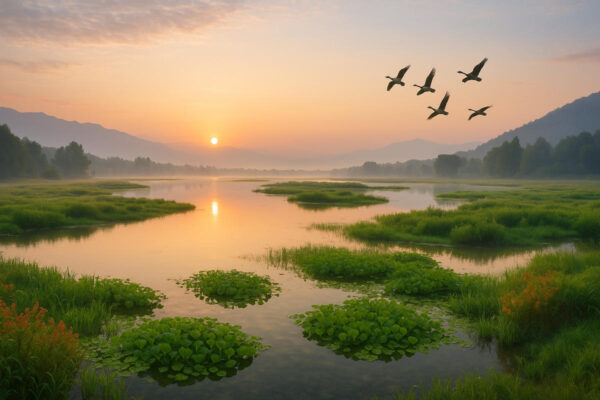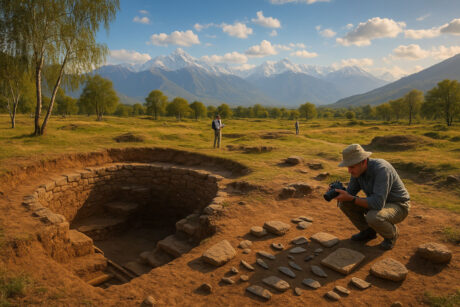Wetlands of Kashmir: A Natural Treasure of Biodiversity and Beauty
Kashmir, often hailed as paradise on earth, is not only famous for its stunning mountains and serene valleys but also for its rich and diverse wetlands. The wetlands of Kashmir are vital ecosystems that support an incredible array of flora and fauna, contribute to climate regulation, and sustain local livelihoods. In this article, we explore the significance, diversity, and conservation efforts surrounding some of the most important wetlands in Kashmir.
What Are Wetlands?
Wetlands are areas where water saturates the soil, either permanently or seasonally, creating unique ecosystems such as marshes, swamps, lakes, and riverbanks. These ecosystems provide habitat for wildlife, help purify water, and prevent floods. Kashmir’s wetlands are critical in maintaining ecological balance in the region.
Major Wetlands of Kashmir
Here are some of the prominent wetlands in Kashmir, each playing a crucial role in biodiversity and local life:
1. Shallabugh Wetland
Shallabugh Wetland is one of the lesser-known yet ecologically significant wetlands in Kashmir, located in the central valley region. This freshwater wetland plays a crucial role as a natural habitat for a variety of aquatic plants and diverse wildlife, especially migratory and resident bird species. The wetland’s rich vegetation provides essential breeding and feeding grounds for numerous birds, including rare and endangered species, making it a vital bird sanctuary in the region. Apart from its biodiversity importance, Shallabugh acts as a natural water reservoir, helping in groundwater recharge and maintaining the hydrological balance of the surrounding agricultural lands. Local communities rely on this wetland for fishing and traditional agriculture, where the wetland’s seasonal flooding enriches the soil with nutrients. However, like many wetlands in Kashmir, Shallabugh faces environmental threats such as pollution, encroachment, and changes in water flow due to human activities. Preserving Shallabugh Wetland is essential not only for maintaining Kashmir’s rich biodiversity but also for supporting the socio-economic fabric of local villages that depend on this ecosystem for their livelihoods. Conservation initiatives focusing on habitat protection, pollution control, and sustainable resource use are critical to safeguard the future of Shallabugh.
2. Hokersar Wetland
Hokersar Wetland, situated near Srinagar, is one of Kashmir’s most prominent and protected wetland ecosystems. Designated as a Ramsar site, Hokersar holds immense ecological value, serving as a key wintering ground for hundreds of migratory bird species that travel thousands of kilometers from Siberia and Central Asia. This wetland’s vast expanse of marshes, shallow lakes, and reed beds creates an ideal habitat for waterfowl such as ducks, geese, cranes, and waders. Apart from birds, Hokersar supports a rich variety of aquatic plants and fish species that contribute to the overall health of the ecosystem. The wetland acts as a natural flood buffer by absorbing excess water from the Jhelum River, helping to prevent flooding in Srinagar and adjacent areas during heavy rainfall and snowmelt. The local communities depend on Hokersar for fishing and grazing, making it an integral part of the region’s traditional lifestyle. Despite its protected status, Hokersar faces challenges from urban encroachment, pollution, and invasive species, threatening its delicate ecological balance. Conservation efforts have focused on habitat restoration, controlling pollution, and community awareness programs to ensure the wetland remains a thriving sanctuary for wildlife and continues to provide essential ecological services.
3. Wular Lake
Wular Lake is one of the largest freshwater lakes in Asia and among the most significant wetlands of Kashmir. Spanning over 30 square kilometers, Wular Lake is a key habitat for diverse fish species, migratory birds such as the Siberian crane, and various aquatic plants. It plays an essential role in flood control, groundwater recharge, and supporting fishing communities.
4. Haigam Wetland
Haigam wetland, located near the northern parts of Kashmir, is a rich biodiversity hotspot known for its unique flora and fauna. It supports various migratory birds and aquatic species, playing a crucial role in maintaining the natural water cycle and local ecological stability.
Importance of Wetlands in Kashmir
-
Biodiversity Hotspots: Kashmir’s wetlands harbor hundreds of species of birds, fish, amphibians, and plants, providing crucial breeding and feeding grounds.
-
Water Purification: These wetlands naturally filter water, trapping sediments and pollutants, improving overall water quality.
-
Flood Control: Wetlands absorb excess rainwater and snowmelt, reducing flood risks in surrounding areas.
-
Livelihoods: Fishing, agriculture, and eco-tourism dependent on wetlands support many local communities, contributing significantly to the economy.
Threats to Kashmir’s Wetlands
Despite their importance, Kashmir’s wetlands face several challenges:
-
Pollution from untreated sewage, agricultural runoff, and waste.
-
Encroachment and illegal land reclamation.
-
Invasion of non-native plant and animal species disrupting ecosystems.
-
Effects of climate change causing altered rainfall patterns and water availability.
Conservation Efforts
To protect these wetlands, government bodies, NGOs, and local communities are working on:
-
Wetland restoration and pollution control initiatives.
-
Raising awareness about sustainable wetland use.
-
Promoting eco-tourism that respects natural habitats.
-
Enforcing regulations against encroachment and habitat destruction.
The wetlands of Kashmir, including Wular Lake, Hokersar, Shallabugh, and Haigam, are invaluable natural treasures that sustain biodiversity, protect the environment, and support local livelihoods. Conserving these wetlands is critical for maintaining the ecological balance and ensuring a sustainable future. Exploring these wetlands offers visitors a unique opportunity to witness the pristine natural beauty and rich wildlife of Kashmir.
FAQs on Wetlands of Kashmir
1. What are the major wetlands in Kashmir?
The major wetlands in Kashmir include Wular Lake, Hokersar Wetland, Shallabugh Wetland, and Haigam Wetland. Each plays a vital role in biodiversity and local livelihoods.
2. Why are the wetlands of Kashmir important?
Kashmir’s wetlands maintain biodiversity, provide habitats for migratory birds, support fisheries, purify water, and control floods. They are essential for the environment and economy.
3. Which migratory birds can be seen in Kashmir’s wetlands?
Many migratory birds such as Siberian cranes, ducks, geese, and cranes visit Kashmir’s wetlands during winter, making it a hotspot for bird watchers.
4. What threats do Kashmir’s wetlands face?
Wetlands face threats like pollution, encroachment, invasive species, and climate change, all impacting their delicate balance.
5. Are there any conservation efforts for wetlands in Kashmir?
Yes, government bodies, NGOs, and local communities are working together on restoration, pollution control, and awareness programs.
6. Can tourists visit Kashmir’s wetlands?
Definitely! Wetlands like Wular Lake and Hokersar are popular for eco-tourism and birdwatching. Responsible tourism is key to protecting these ecosystems.
7. How do wetlands benefit local communities in Kashmir?
They provide fishing resources, fertile land for agriculture, and flood protection, supporting the livelihoods of many Kashmiris.












